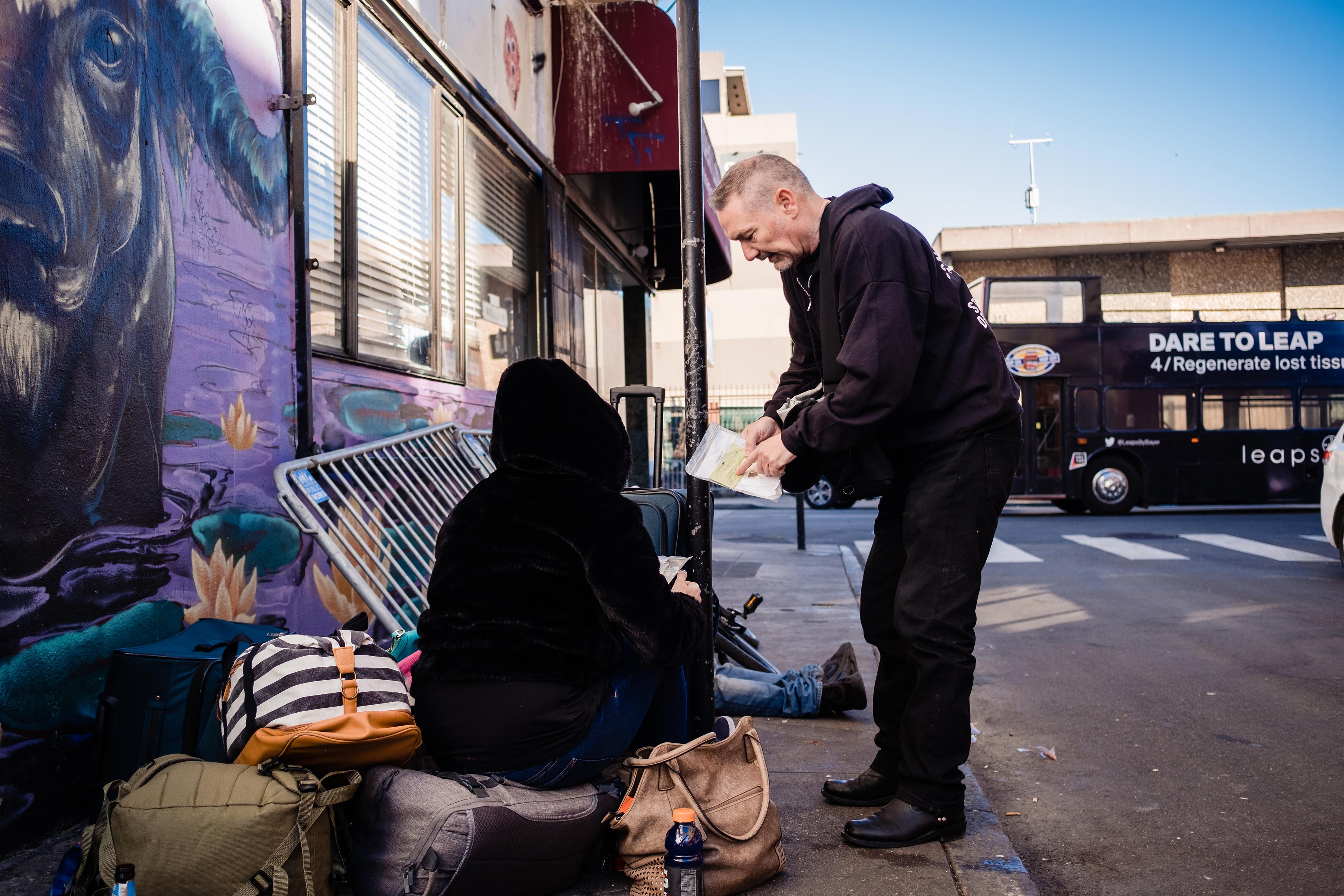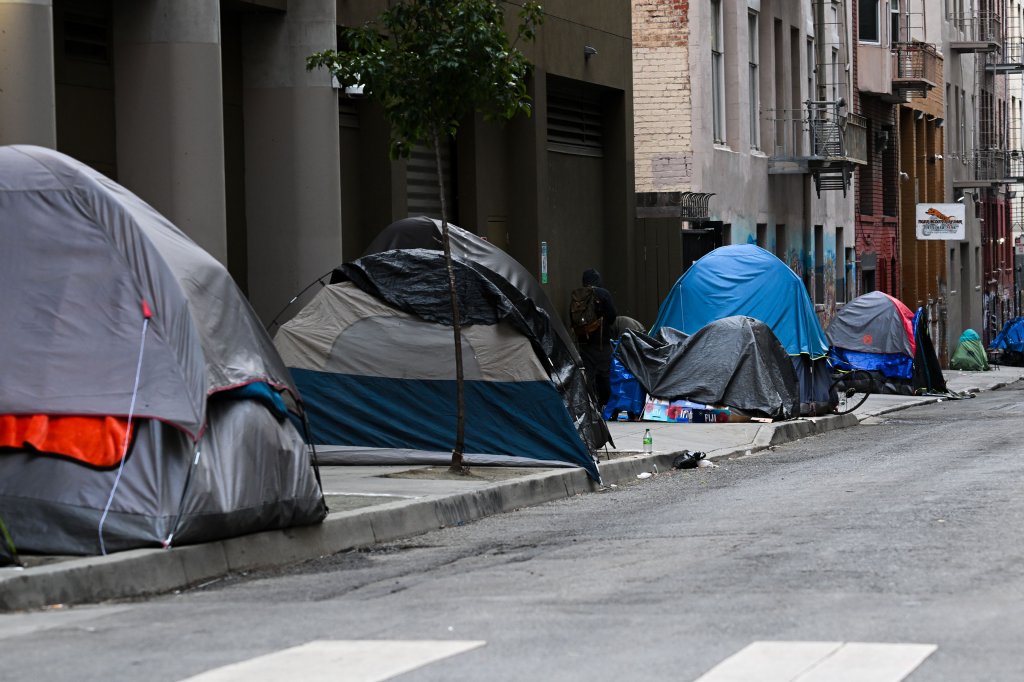Raymond Llano carries a plastic bag with everything he owns in one hand, a cup of coffee in the other, and the flattened cardboard box he uses as a bed under his arm as he waits in line for lunch at Glide Memorial Church in San Francisco. At 55, he hasn’t had a home for 15 years, since he lost a job at Target.
Llano once tried to get on public assistance but couldn’t — something, he said, looking perplexed, about owing the state money — and he’d like to apply again.
But beginning next year, if he does, he’ll face a new city requirement that single adults with no dependents who receive cash benefits be screened for illegal drug use and, if deemed necessary, enter treatment. San Francisco’s voters approved the new mandate in March.
Llano has no objection to being screened. He said he uses cannabis, which is legal in California, though not federally, but does not use other drugs. Nonetheless, he said, “I suppose I would try recovery.”
Another man in the free-lunch line, Francis Farrell, 56, was far less agreeable. “You can screen me,” he said, raising his voice, “but I don’t think you should force me into your idea of treatment.”
No one will be forced to undergo substance abuse treatment, nor will anyone be subject to drug testing, San Francisco officials insist. Rather, starting in January 2025, San Francisco’s public assistance recipients who screen positive for addiction on a 10-question drug abuse test will be referred to treatment. Those who refuse or fail to show up for treatment will forfeit the $109 a month that the city grants to homeless adults who qualify for city shelters or supportive housing, or the $712 a month it grants to adults with home addresses.
The city famous for its tolerance is resorting to tough love.
Trent Rhorer, executive director of the San Francisco Human Services Agency, cited three reasons for the new measure, which was fashioned after similar policies in Los Angeles and New York: to incentivize people with a substance use disorder to enter treatment, to prevent taxpayer money from being used to buy illegal drugs, and to dissuade drug seekers from moving to San Francisco.
“We’re giving them the opportunity to engage in something, without requiring sobriety, to hopefully get on a path to recovery,” Rhorer told California Healthline.
When Mayor London Breed introduced the ballot initiative known as Measure F in a news conference last year, she called it an incentive to encourage drug-addicted recipients of public assistance to enter “into a program that will help save their life.” Accidental overdoses killed more than 800 people in San Francisco last year.
But in the eyes of many health care providers, researchers, and harm reduction advocates, the measure is neither an incentive nor an opportunity.
The policy was designed to have “a coercive, punitive effect” and could do more harm than good, said Vitka Eisen, president and chief executive of HealthRIGHT 360, San Francisco’s largest drug treatment provider.
“It would have been an interesting project, much more in the spirit of San Francisco as a hub of innovation, to figure out if we can identify people with substance use disorder. And if they go into treatment and stay for a period of time, they’ll get an increased benefit,” Eisen said.
About 5,800 people in the city currently receive benefits from the County Adult Assistance Programs, or CAAP. Under Measure F, those who acknowledge drug abuse on the screening test but refuse treatment and live in city-provided shelter will lose their cash benefits but can maintain their shelter, Rhorer said. However, CAAP recipients who refuse treatment and depend on public assistance to pay their rent in private housing could lose their homes.
The city will give recipients three chances to show up for treatment and will pay rent directly to a landlord for one month, Rhorer said. Measure F came in response to the grim conditions on some San Francisco streets, where men and women lie on sidewalks, often blocking passersby with their arms and legs splayed, or stand bent over, frozen like statues. Many use fentanyl, a synthetic opioid that has turned a long-standing homelessness problem into a public health emergency.


About 12% of people who fatally overdosed in San Francisco last year were CAAP recipients, Rhorer said.
Compassion fatigue seems to have settled over this city known for its kindheartedness. Measure F proponents raised $667,000 — more than 17 times as much as opponents — largely from business executives and tech investors, according to the San Francisco Ethics Commission. Then in March, 58% of voters approved the measure.
Since fentanyl began replacing heroin around 2019, Rhorer said, “drug tourists” have flocked to San Francisco, where the opioid has been cheap and plentiful. Lenient law enforcement and relatively generous cash public assistance grants also have drawn people with addiction, he said, although police activity has increased since last spring.
A recent city report found that only 53% of the 718 people whom police cited for substance use over a 10-month period that ended in February said they lived in the city.
“People who live in San Francisco, who really need the most help, don’t get the help they need due to the influx of people coming from somewhere else,” said Cedric Akbar, who runs recovery programs and co-founded Positive Directions Equals Changes. “And should our tax dollars go to the ones in San Francisco, or are we going to take care of the whole country?”
Akbar began using heroin when he moved to San Francisco from Houston in the 1980s and has been in recovery for 31 years. He said he would have preferred even stricter requirements for eligibility for public assistance than those in Measure F but hopes the new mandate will at least help give people access to treatment.
The city’s capacity for treatment is also a concern. Eisen and others describe a dire shortage of behavioral health workers to staff treatment facilities and residential step-down units, which are crucial for housing those in recovery from drug addiction.
New programs funded by the recently approved Proposition 1 in California, which authorizes the state to spend $6.38 billion to build mental health treatment facilities and provide housing for homeless people, are meant to address the shortages.
Leslie Suen, an addiction medicine physician and an assistant professor at the University of California-San Francisco, fears that pushing CAAP recipients into treatment could turn them off. When people “were stigmatized, or coerced, or told they would face consequences if they didn’t do a certain thing,” she said, “that pushed them away from the health system even further.”
Though evidence suggests compulsory treatment can provide short-term benefits, it also can lead to long-term harm, the National Institute on Drug Abuse said in an email.
“To achieve the best outcomes,” the email said, treatment should be “delivered without stigma or penalty.”
Almost everyone with a substance use disorder enters treatment under some kind of pressure, whether from a parent, a spouse, an employer, or the criminal justice system, said Keith Humphreys, a Stanford University psychiatry professor.
Nonetheless, he questioned the morality of requiring welfare recipients, as opposed to criminals, to get drug treatment.
“I would never start with people who are poor but not committing crimes,” he said. “I would start with people who are harming others.”



